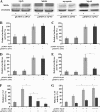Down-regulation of MyoD by calpain 3 promotes generation of reserve cells in C2C12 myoblasts
- PMID: 20139084
- PMCID: PMC2857084
- DOI: 10.1074/jbc.M109.063966
Down-regulation of MyoD by calpain 3 promotes generation of reserve cells in C2C12 myoblasts
Abstract
Calpain 3 is a calcium-dependent cysteine protease that is primarily expressed in skeletal muscle and is implicated in limb girdle muscular dystrophy type 2A. To date, its best characterized function is located within the sarcomere, but this protease is found in other cellular compartments, which suggests that it exerts multiple roles. Here, we present evidence that calpain 3 is involved in the myogenic differentiation process. In the course of in vitro culture of myoblasts to fully differentiated myotubes, a population of quiescent undifferentiated "reserve cells" are maintained. These reserve cells are closely related to satellite cells responsible for adult muscle regeneration. In the present work, we observe that reserve cells express higher levels of endogenous Capn3 mRNA than proliferating myoblasts. We show that calpain 3 participates in the establishment of the pool of reserve cells by decreasing the transcriptional activity of the key myogenic regulator MyoD via proteolysis independently of the ubiquitin-proteasome degradation pathway. Our results identify calpain 3 as a potential new player in the muscular regeneration process by promoting renewal of the satellite cell compartment.
Figures










Similar articles
-
Calpain 3 Expression Pattern during Gastrocnemius Muscle Atrophy and Regeneration Following Sciatic Nerve Injury in Rats.Int J Mol Sci. 2015 Nov 11;16(11):26927-35. doi: 10.3390/ijms161126003. Int J Mol Sci. 2015. PMID: 26569227 Free PMC article.
-
Mitochondrial dysfunction and consequences in calpain-3-deficient muscle.Skelet Muscle. 2020 Dec 11;10(1):37. doi: 10.1186/s13395-020-00254-1. Skelet Muscle. 2020. PMID: 33308300 Free PMC article.
-
m-Calpain implication in cell cycle during muscle precursor cell activation.Exp Cell Res. 2004 Aug 1;298(1):48-57. doi: 10.1016/j.yexcr.2004.03.053. Exp Cell Res. 2004. PMID: 15242761
-
The transcriptional co-repressor TLE3 regulates myogenic differentiation by repressing the activity of the MyoD transcription factor.J Biol Chem. 2017 Aug 4;292(31):12885-12894. doi: 10.1074/jbc.M116.774570. Epub 2017 Jun 12. J Biol Chem. 2017. PMID: 28607151 Free PMC article.
-
Regulation of the M-cadherin-beta-catenin complex by calpain 3 during terminal stages of myogenic differentiation.Mol Cell Biol. 2006 Nov;26(22):8437-47. doi: 10.1128/MCB.01296-06. Epub 2006 Sep 18. Mol Cell Biol. 2006. PMID: 16982691 Free PMC article.
Cited by
-
Calpain 3 deficiency affects SERCA expression and function in the skeletal muscle.Expert Rev Mol Med. 2016 Apr 8;18:e7. doi: 10.1017/erm.2016.9. Expert Rev Mol Med. 2016. PMID: 27055500 Free PMC article.
-
Impaired regeneration in LGMD2A supported by increased PAX7-positive satellite cell content and muscle-specific microrna dysregulation.Muscle Nerve. 2013 May;47(5):731-9. doi: 10.1002/mus.23669. Epub 2013 Mar 29. Muscle Nerve. 2013. PMID: 23553538 Free PMC article.
-
Calpain 3 is important for muscle regeneration: evidence from patients with limb girdle muscular dystrophies.BMC Musculoskelet Disord. 2012 Mar 23;13:43. doi: 10.1186/1471-2474-13-43. BMC Musculoskelet Disord. 2012. PMID: 22443334 Free PMC article.
-
Myosin heavy chain-embryonic regulates skeletal muscle differentiation during mammalian development.Development. 2020 Apr 6;147(7):dev184507. doi: 10.1242/dev.184507. Development. 2020. PMID: 32094117 Free PMC article.
-
Expression profiles and transcript properties of fast-twitch and slow-twitch muscles in a deep-sea highly migratory fish, Pseudocaranx dentex.PeerJ. 2022 Mar 30;10:e12720. doi: 10.7717/peerj.12720. eCollection 2022. PeerJ. 2022. PMID: 35378928 Free PMC article.
References
-
- Hawke T. J., Garry D. J. (2001) J. Appl. Physiol. 91, 534–551 - PubMed
-
- Cooper R. N., Tajbakhsh S., Mouly V., Cossu G., Buckingham M., Butler-Browne G. S. (1999) J. Cell Sci. 112, 2895–2901 - PubMed
-
- Cornelison D. D., Wold B. J. (1997) Dev. Biol. 191, 270–283 - PubMed
-
- Smith C. K., 2nd, Janney M. J., Allen R. E. (1994) J. Cell. Physiol. 159, 379–385 - PubMed
-
- Baroffio A., Bochaton-Piallat M. L., Gabbiani G., Bader C. R. (1995) Differentiation 59, 259–268 - PubMed
Publication types
MeSH terms
Substances
LinkOut - more resources
Full Text Sources
Other Literature Sources
Molecular Biology Databases

